Top News
September 27, 2017 Ryukyu Shimpo
Tokyo – Japan’s Ministry of Economy, Trade, and Industry (METI) announced September 26 that for the first time ever, a large quantity of minerals, including valuable resources such as gold, were successfully extracted from an approximately 1,600 meter-long hydrothermal mineral deposit in the sea floor off the coast of Okinawa.
METI expects that the increase ore extraction efficacy will lead to establishing the techniques for a domestic industry in the mineral resources most nations rely on, and commercialization.
METI noted that, “If a sufficient quantity of mineral deposits can be confirmed, it is possible that Japan could become a resource-exporting nation.”
METI, in collaboration with Japan Oil, Gas, and Metals National Corporation (JOGMEC), have been conducting a geological survey on the ocean floor off the coast of Okinawa since mid-August.
In the survey, ore was extracted from sea floor hydrothermal mineral deposits formed by hot water springing from the ocean floor, depositing metals such as copper, lead, gold, and silver.
Around 16 tons of ore was extracted by sucking it up along with seawater using a large pump.
This method allowed for a more effective extraction of ore than previous unmanned extraction methods.
METI determined that the mineral deposit excavated in this survey contains approximately the same amount of zinc that Japan uses in a year.
With the success of the survey, METI will move forward with their 2018 economic evaluation, and consider if this can lead to commercialization in the future.
METI Minister Hiroshige Seko commented at the press conference September 26 that, “I would like to work with private industry to plan for commercial development, and work on policies related to resource quantity, quality, and industrial technology.
(English translation by T&CT and Sam Grieb)
Go to Japanese
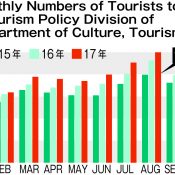
September 22, 2017 Ryukyu Shimpo
On September 21 the Okinawa Department of Culture, Tourism and Sports announced that the number of tourists who came to Okinawa in August increased by 8.2 percent (or 75,600 people) from August last year to 1,002,500 people this year.
This is the first time that the number of tourists visiting within a month-long period has exceeded 1,000,000 people. August 2017 is the forty-sixth consecutive month that a record high for one specific month was achieved (i.e. this year marks the all-time high record for August), and the fifty-ninth consecutive month that the numbers were higher than those of the same month the previous year.
Okinawa’s benchmark for inbound tourists both foreign and domestic in 2017 is 9,500,000, and that number is being approached at a steady pace.
When the numbers are broken down, since last August domestic tourism from elsewhere in Japan to Okinawa increased 4.6 percent to 726,800 people, and foreign tourism to Okinawa has grew 18.8 percent to 275,700 people.
This is the first time domestic tourists have exceeded 700,000 people within a month.
In conjunction with the summer tourism boom, Okinawa’s tourist industry saw favorable trends.
The number of flights along air routes to Okinawa and the number of times cruise ships docked in Okinawa rose.
In addition, the lack of typhoon occurrences boosted this upward shift. An Okinawan official presented the analysis: “We are supporting the remarkable increase in foreign tourists and growing numbers of those coming to the region.
And yet the boom of domestic tourists, accounting for more than half of all [tourists to Okinawa], is huge.”
If domestic tourism between last August and this August is itemized: tourism from Tokyo grew 2.2 percent to 359,200 people, Kansai rose 5.2 percent to 153,100, Fukuoka increased 10.2 percent to 88,400, and Nagoya grew 6.4 percent to 58,300.
As for itemizing foreign tourism: those from Taiwan rose 34.3 percent to 89,300 people, South Korea increased 8.2 percent to 43,400, mainland China grew 15.6 percent to 65,900, and Hong Kong rose 19.6 percent to 27,500.
On a list of countries from which the most tourists came from abroad to Okinawa, the United States ranks fifth after the above-listed countries.
Since direct flights between Okinawa and Thailand were established in February, tourism from Thailand has increased 9.5 times from last August to 1,900 people this August.
(English translation by T&CT and Erin Jones)
Go to Japanese
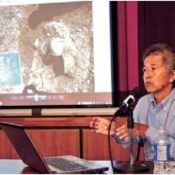
September 25, 2017 Ryukyu Shimpo
On September 24, representative Takamatsu Gushiken of the Gamafuya, a volunteer group dedicated to the recovery of Battle of Okinawa remains, held a lecture at Asato Catholic Church in Asato, Naha City. About 60 people attended the lecture, during which Gushiken explained that remains recovery is significant because it can teach people about the succession of the Battle of Okinawa.
He said: “When children see the bones with their own eyes, they can feel the reality that this was a battle site.
It makes them question, ‘Why did these people have to be killed?’”
Back in 2009, he displayed some photographs of remains recovery in Makabi, Naha City, while explaining that, “human bones fell apart as they were brought out [of the ground].
” He said he felt the true ferocity of the battle from studying the damaged remains of the Japanese and American soldiers.
At that time, Gushiken pointed out that as post-war residents of the area had begun their own efforts to recover war remains, it was becoming important to convey the significance of the Battle of Okinawa.
He said to local elementary school pupils attending for peace studies: “When you have seen the bones, you can say that Makabi was a battle site.
Why did such a thing occur? Think, when you grow up, could such a terrible thing happen again?”
At his lecture at the Asato Catholic Church, Gushiken touched on the recent incident of young men damaging the Chibichiri Gama cave in Namihira, Yomitan Village.
The young men said they went to the shinrei spot (haunted location) to test their courage.
Gushiken said that upon hearing about this he felt frustration that he was not able to pass on the lessons of the Battle of Okinawa to younger generations.
He said, “We must all, myself included, revisit the way in which we show our respect and remembrance for the war dead.”
Furthermore, Gushiken mentioned something he had come to realize through remains recovery.
He came to recognize that killing, deeming killing acceptable, and killing oneself are all wrong; the Battle of Okinawa forced these actions.
(English translation by T&CT and Erin Jones)
Go to Japanese
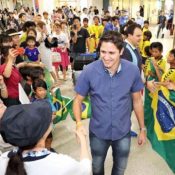
September 21, 2017 Ryukyu Shimpo
Retired Pro soccer player José Edmílson Gomes de Moraes, who represented the Brazilian national team at the FIFA World Cup hosted by Japan and South Korea in 2002, landed at Naha Airport the evening of September 20, to teach at Japan’s first official Brazilian Football Confederation (CBF – Portuguese: Confederação Brasileira de Futebol) soccer camp which opened September 21 in Naha. Edmílson said he was eager to, “teach the children the philosophy of Brazilian soccer, which features a lot of creativity and improvisation.”
Around 150 fans, including some of the children who would be participating in the camp, packed into the airport to welcome Edmílson.
Akira Gushiken, president of the Okinawa Football Association welcomed Edmílson, saying, “I am pleased to bring in footballers like Edmílson as instructors, so that the children can take their soccer skills worldwide.”

Edmílson answering questions at the press conference.
After the welcome, a press conference was held at the airport.
Edmílson said to the youth players going to the camp to, “not only work hard, but also have fun,” and that he wanted to “teach them about following their dreams of becoming international footballers and the wonders of finding success there.”
The hosts of the soccer camp reached out to Ex-Kawasaki Frontale player Yoshiaki Hayashi to act as an intermediary for contacting Edmílson.
Both Hayashi and Edmílson belonged to the same club soccer team back when Hayashi was studying abroad in Brazil.
Hayashi said, “Seeing a world-class soccer player can have a major lasting impact on children.
Because Edmílson has a strong personality, I know how important sharing his experiences are.”
Edmílson is scheduled to visit the Okinawa Athletic Association and the Okinawa Football Association during the camp on September 21.
(English translation by T&CT and Sam Grieb)
Go to Japanese
September 22, 2017 Ryukyu Shimpo
On September 21, the Okinawa Prefectural Department of Public Health and Medical Care announced finalized statistics regarding demographics in Okinawa Prefecture in 2016.
There were 16,617 births in 2016, meaning a birth rate of 11.6 per 1,000 people, which is 3.8 percentage points higher than the national average, putting Okinawa in first for 43 years in a row.
Meanwhile, the number of deaths rose, and the natural growth rate, calculated by subtracting the number of deaths from the number of births, fell to 4,911, which is 704 lower than the previous year’s figure. The natural growth rate per 1,000 people was 3.4, the only positive case among all of Japan’s prefectures, but it was the lowest it has been since Okinawa’s reversion to Japan in 1972.
According to the announcement, the number of births in 2016 fell by 324 year on year, and the birth rate fell by 0.3 percentage points.
Average daily births were 45.5, meaning one person born every 31 minutes and 38 seconds.
The total special birth rate, which is the estimated number of children per woman in her lifetime, was 1.95 (national average: 1.44), a 0.01 point decrease year on year, putting Okinawa at number one for 32 years in a row.
The number of deaths was 11,706, an increase of 382 compared to the previous year, and the death rate per 1,000 people rose 0.2 points to 8.2. The average number of deaths per day was 32.1, meaning one death every 44 minutes and 54 seconds.
The death rate was 2.3 points lower than the national average, and the lowest nationwide for 15 years in a row.
The most prevalent cause of death was malignant neoplasm (cancer) at 3,074 cases, followed by cardiac problems at 1,670 cases and cerebrovascular problems at 932 cases.
The number of stillbirths was 434, 11 more than the previous year.
The stillbirth rate per 1,000 people was 25.5, 1.1 points higher than the previous year, and 4.5 points higher than the national average.
The number of marriages was 8,464 (231 less than the previous year), and the number of divorces was 3,700 (97 more than the previous year).
(English translation by T&CT and Sandi Aritza)
Go to Japanese
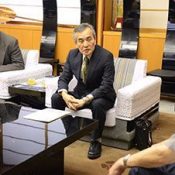
September 22, 2017 Ryukyu Shimpo
On September 19, Global Education Harvard Medical School Executive Director Robin J.
Wheatley and nonprofit corporation Okinawa Asia Clinical Investigation Synergy (OACIS) Vice President Kenji Murata met with Governor Takeshi Onaga at the Okinawa Prefectural Office.
They explained the details regarding the Global Clinical Scholars Research Training (GCSRT) Program hosted by Harvard that is to take place next January at the Okinawa Institute of Science and Technology (OIST) Graduate University.
Governor Onaga welcomed the program by saying, “This program should be welcomed with open arms and will stimulate the growth of Okinawa’s medical care.”
Harvard University’s GCSRT Program is a part of an effort to foster medical personnel on a global scale.
This will be the first time in which it takes place in Japan.
Between next January to next July, people will be able to learn about clinical epidemiology and clinical trials through lectures at OIST and bi-directional conferences via the Web. In addition, attendees will form teams to progress discussions for their dissertations.
Harvard expects people to attend from all over the world. Tuition is expected to cost $6,000.
Vice President Murata, who contributed in attracting this program to Japan, says, “Clinical research statistically analyzes the patient’s data to see if a currently available treatment method will be effective or not.
Clinical research can also analyze results regarding cost using computers.
Japan has been doing such research, but America’s is more advanced.
” He has high hopes that through this program, Japan’s clinical research will grow.
Details about this program can be found on Okinawa Asia Clinical Investigation Synergy’s (OACIS) homepage: http://oacis.org
(English translation by T&CT and Chelsea Ashimine)
Go to Japanese
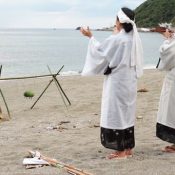
September 24, 2017 by Ryukyu Shimpo
Kunigami – The Unjami festival, one of Japan’s Important Intangible Folk Cultural Properties, was held in Yona, Kunigami (Tadanobu Miyagi, Mayor), where there were prayers for bountiful harvest and good health. The festival is held each year on the day of the bull of the lunar Bon Festival.
On the day of the festival, two kaminchu wait inside the temple.
Then, around 4:00 p.m., after preparations have been made, they lead a procession down to Asagima, where the kaminchu lead prayer, and starting with Mayor Miyagi, serve ceremonial sake and give blessings to representatives from each of the village households.
The ceremony begins on the eastern edge of the village with a prayer while facing the mountains to the east at Unkoi gate, where they greet the gods.
Then, they strike the sand-covered ground with a bow, chanting “Unkoi, Unkoi” three times to wake the sleeping god, before spinning counter-clockwise seven times.
Upon returning to Asagima, three ceremonies are performed: “Boat Rowing,” “Boar Hunting,” and “Fishing.
” This year, Yasushi Kamiyama, 25, was in charge of the boar hunt, which involves shooting a boar made from a winter melon with a bow.
Same as previous years, the area children got to try this as well as the boat rowing and the fishing, led by Yushi Miyagi, 28, and Toshiki Tsuha, 20.
After the ceremony at Asagima, following the signal drum, the children carrying their slain boars, the kaminchu, and the other participants proceed down to Yona Beach for the “Nagashi” ceremony.
Along the way, the procession stops at an alley, where the drummer shouts a long call, to which the participants respond with, “Yo-sare,” which is repeated nine times on the way down to the beach, showing the gods the way.
At the beach, they pray while facing out over the East China Sea.
The festival ends with the children offering the boars they have carried down to the gods, sending them out into the current of the sea.
(English translationg by T&CT and Sam Grieb)
Go to Japanese
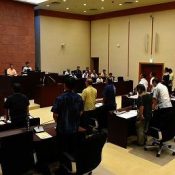
September 22, 2017 Ryukyu Shimpo online edition
On the morning of September 22, the Kadena Town Council held a session at which they unanimously adopted a resolution and statement of protest against the parachute drop training carried out on the 21st at the U.S. Kadena Air Base.
The Council also called for the abolishment of the exceptional use of Kadena Base clause confirmed at the SACO agreement in 2007.
In the resolution and statement of protest, the Council spoke out against the training carried out in April and May this year and a schedule of training in June.
“If the training becomes normalized, it would go against the idea of reducing the base burden and would obviously lead to strengthening the base function.”
Kadena Town Council members visited the Okinawa Defense Bureau to make their appeal on the afternoon of the 22nd.
(English translation by T&CT and Megumi Chibana)
Go to Japanese
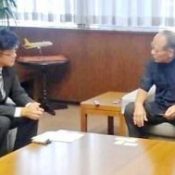
September 14, 2017 Ryukyu Shimpo
An LCC airline company, Vanilla Air, will start training pilots at the Shimojijima Airport in Mijakojima city, Okinawa, from October 11.
The training is planned to be held twice a year, and each training will last at least five days.
Eight pilots will participate in approximately 100 rounds of touch-and-go training using the Airbus A320.
President of Vanilla Air, Katsuya Goto, who visited vice governor Tadaaki Urasaki at the prefectural government office on September 13 announced the plan.
President Goto expressed his gratitude for the prefecture allowing the company to conduct its training program, saying, “We can carry out efficient flight training at the Shimojijima Airport.
We hope this opportunity will be a chance for the island to be known widely in the country.”
As for the reason why the company chose to conduct training, he explained; “it is because we can shorten our training period and we can arrange the schedule more flexibly.”
Vice governor, Urasaki, welcomed the training remarking, “We appreciate the company for utilizing the 3000-meter runway.
We hope the training will lead to further economic opportunities.”
The use fee charged by the Shimojijima Airport to the prefecture dropped drastically after Air Nippon Airways ended its flight training at the airport in 2015.
Currently the Ryukyu Air Commuter and the First Flying use the airport for their training.
(English translation by T&CT and Sayaka Sakuma)
Go to Japanese
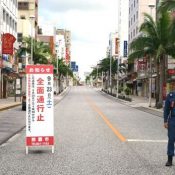
September 24, 2017 Ryukyu Shimpo
On September 23 at a hotel construction site in a main street full of shops and restaurants in Naha City, an unexploded bomb from the Battle of Okinawa was disposed of.
Police blocked roads around the Matsuo intersection including Kokusai Street for about an hour from around 10:20 a.m.
According to Naha City officials, it was the second time unexploded ordinance disposal had been carried out on Kokusai Street since 2004.
About 2,500 residents of approximately 1,000 households and employees of around 350 business establishments including hotels, souvenir shops, restaurants and convenience stores located within a 166-meter radius of the disposal site were urged to evacuate.
The shops in the evacuation area were temporarily closed during the disposal work.
About 100 members of the Naha City Office, the City Fire Department, the Okinawa Prefectural Government, the Naha Police Station and the Japanese Ground Self Defense Force took part in the unexploded ordinance disposal, as well as traffic control and evacuation guidance.
The unexploded ordinance was a U.S.-made 50-kilogram bomb, which was discovered on the hotel construction site on August 3.
A bomb-disposal team from the Ground Self Defense Force used a crane to place the unexploded bomb into a hole, which had a diameter of 3 meters and a height of 6 meters, and then removed the bomb’s detonation cord.
Shiroma, head of the local emergency response headquarters, said, “We are very worried about the citizens because the area has heavy pedestrian and motor vehicle traffic.
It has been a big challenge for us. I am relieved to be able to finish the task safely.”
(English translation by T&CT)
Go to Japanese

September 15, 2017 Ryukyu Shimpo
The Okinawa Defense Bureau (ODB) conducted a study of flight operations at both Futenma Air Station and Kadena Air Base in April through July, observing the bases 24 hours a day.
The results were reported to the governments of Okinawa Prefecture, Ginowan City, and Kadena Town on September 14. The numbers of flight operations (including instances of aircraft performing takeoff, landing, touch-and-go, passing overhead, and circling the base) recorded in the four-month period ending in July were 5,084 at Futenma and 18,799 at Kadena.
At Futenma Air Station, flight operations performed between 10:00 p.m. and 6:00 a.m., late night and early morning hours that are restricted by aircraft noise regulation measures in the noise prevention agreement, numbered 224.
Out of these 224 instances, 97 occurrences or 43 percent of the transgressions were MV-22 Osprey vertical takeoff and landing aircraft.
At Kadena Air Base, one-third of the takeoffs and landings were foreign aircraft (coming from bases in the United States and overseas).
Through this study the burdens of late night flights and foreign aircraft have been expressed numerically.
The most flight operations to be observed within a month-long period at Futenma Air Station were 1,678 in April alone.
Also, operations conducted at Futenma after 10:00 p.m. numbered 91 in July.
The time slot of 7:00 p.m. until 9:59 p.m., during which Ginowan City and other bodies have requested flight operations be restricted, was subject to 1,081 flights between April and July.
Due to runway maintenance and repair work at Futenma Air Station, fixed-wing aircraft were unable to takeoff and land there as usual throughout the study period, meaning only 37 of foreign incoming flights were recorded.
At Kadena Air Base the monthly flight operation numbers saw an upward trend.
In April there were 3,931 recorded operations, but in June there were 5,283 and in July there were 5,202.
On September 14 at Kantei (the prime minister’s official residence) at a meeting of a working group promoting Futenma Air Station burden reduction, the Okinawa Prefecture and Ginowan City governments made the request to the Japanese government that daily study results also be supplied.
(English translation by T&CT and Erin Jones)
Go to Japanese










 Webcam(Kokusai Street)
Webcam(Kokusai Street)


